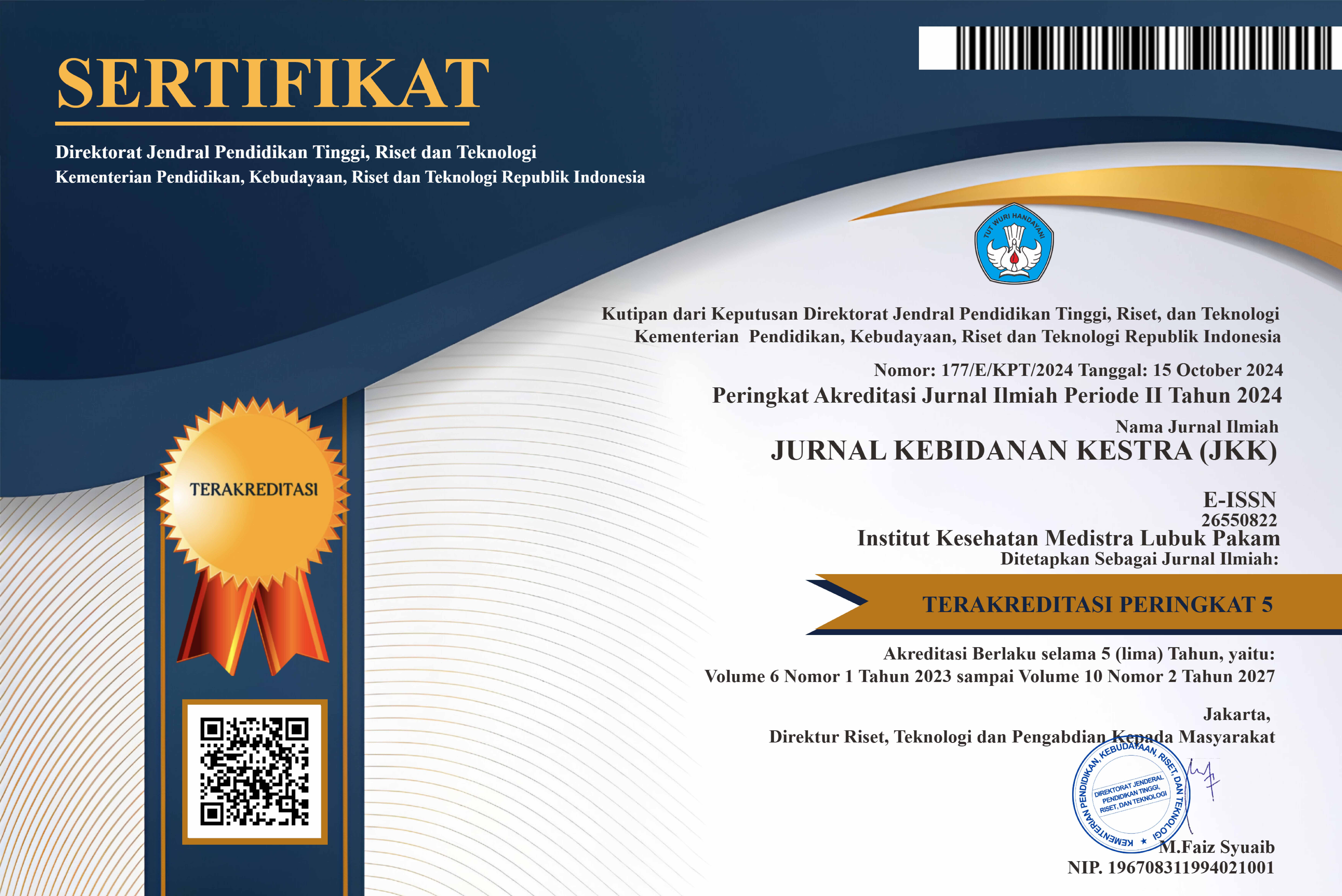The Relationship Between Nutritional Status With The Growth And Development Of Toddlers 1-3 Years In Pratama Bunda Patimah Clinic
DOI:
https://doi.org/10.35451/jkk.v5i2.1631Keywords:
Nutritional Status, Growth, Development, Toddlers 1-3 YearsAbstract
Nutritional status is the result of a balance with food intake and the need for nutrients in the human body. Nutritional status is influenced by diet and the ability of these nutrient levels in the process of maintaining normal metabolic integrity. This research method uses descriptive analytic. The population in this study were all toddlers 1-3 years. The research sample used the total population technique. Data collection uses Primary and Secondary data. The data analysis technique uses the chi-square test. The results obtained from data analysis using the chi-square test showed that out of 25 respondents (75.7%) with good nutritional status with good growth, 24 respondents (72.7%) had good nutritional status with poor growth, 1 respondent (3, 0%) from the results of the chi-square test showed a significant value, the p-value was 0.007 <0.05, so it was concluded that there was a relationship between nutritional status and growth. Of the 33 respondents, it was shown that out of 25 respondents (75.8%) good nutritional status with appropriate progress was 25 respondents (75.8%), good nutritional status with doubtful development was 0 respondents (0.0%), good nutritional status with the development of deviations of 0 respondents (0.0%) from the results of the chi-square test showed a significant value obtained p-value was 0.005 <0.05 so it was concluded that there was a relationship between nutritional status and development. It was concluded that there is a relationship between Nutritional Status and the Growth and Development of Toddlers 1-3 Years at the Bunda Patimah Primary Clinic in 2022. It is recommended for places and health workers to increase monitoring of nutritional status, growth and development of children, carry out routine early detection of irregularities in child growth and development.
Downloads
References
Husna, L. N., & Izzah, N. (2021, November). Gambaran Status Gizi Pada Balita: Literature Review. In Prosiding Seminar Nasional Kesehatan (Vol. 1, pp. 385-392).
Kemenkes RI. 2017. Gizi, investasi masa depan bangsa. Jakarta : Kementeran Kesehatan RI.
Oktarindasarira, Zelita. Hubungan Pengetahuan, Pekerjaan Ibu Dan Pendapatan Keluarga Dengan Status Gizi Balita Di Wilayah Kerja Puskesmas Tapin Utara Tahun 2020. Diss. Universitas Islam Kalimantan MAB, 2020.
Martha Pitaloka, Putri, Dary Dary, and Gelora Mangalik. "ASUPAN PROTEIN, ZAT BESI DAN STATUS GIZI PADA REMAJA PUTRI." Journal of Nutrition College 11.1 (2022): 6-17.
Noviati Fauda. "STATUS GIZI ANAK BADUTA (BAWAH DUA TAHUN) DI INDONESIA." Jurnal Litbang Provinsi Jawa Tengah 15.1 (2017): 51-63.
Riskesdas, 2018. Laporan Provinsi Sumatera Utara Riskesdas 2018. Badan Penelitian dan Pengembangan Kesehatan.
Rati Dwi, Sanitasari, Desi Andreswari, and Endina Putri Purwandari. "Sistem Monitoring Tumbuh Kembang Anak Usia 0-5 Tahun Berbasis Android." Rekursif: Jurnal Informatika 5.1 (2017).
Soetjiningsih, IG. N. Gde Ranuh, (2019). Tumbuh Kembang Anak Edisi 2.Jakarta : EGC
Setiawati, Erna Rahma Yani, and Megah Rachmawati. "Hubungan status gizi dengan pertumbuhan dan perkembangan balita 1-3 tahun." Holistik Jurnal Kesehatan 14.1 (2020): 88-95.
Downloads
Published
Issue
Section
License
Copyright in each article is the property of the Author.



























